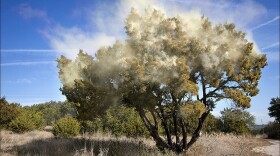These days, "cedar fever" is nothing to sneeze at. The severity of the cedar allergy season we’re in right now is near record-highs, with a count of over 21,400 parts per million on Wednesday – the second highest reading in history. In Austin, it’s common to experience a bout of cedar fever in winter months. But allergist Dr. Seth Hollander says the weather over the past few years has made it even worse.
“[W]e had an early winter when it actually got cold and dry, which more or less primed the cedar trees and told them that it was a good time to pollinate,” says Hollander. “What we experienced in January was, when they actually did pollinate, there [were] a whole lot of them that were ready to go and it resulted in some near-record high pollen counts.”
If you haven’t experienced the agony of cedar fever, then consider yourself lucky – either you are immune to the polemic pollen or, strangely enough, you haven’t been living here long enough.
“Central Texas does have a fairly unique environment in that not only do we have all the spring and fall blooming plants, such as oak and ragweed, but we do have mountain cedar, which a lot of other parts of the state don’t experience,” Hollander says. “And so from that standpoint, typically, when patients move to Austin from other parts of Texas, their allergies do tend to get worse.”
While there’s plenty of cedar pollen out there, there won’t be much risk of reaching the extremes of last weekend’s levels. The worst of the season is most likely behind us for this season, but allergy sufferers aren’t out of the forest yet – cedar season typically lasts through February.




